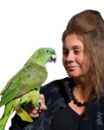The Need for Voice
An Interview with Vera Muller-Paisner on Treating Horse and Human Trauma
In the course of the development of civilization man acquired a dominating position over his fellow-creatures in the animal kingdom. Not content with this supremacy, however, he began to place a gulf between his nature and theirs. He denied the possession of reason to them, and to himself he attributed an immortal soul. - Sigmund Freud
As part of the series on exploring trauma and trauma recovery across species, this interview turns toward psychoanalysis and the Eye Movement Desensitization and Reprocessing (EMDR) protocol as practiced by Vera Muller-Paisner. A psychoanalyst with a master’s degree in social work, Vera has spent the last three decades years studying the chronicity and transmission of trauma. In 1996, she served as a research consultant for the International Study Group for Trauma at Yale University, and in 1996 received an appointment in the Department of Psychiatry, Yale University School of Medicine.
Vera has conducted extensive research and clinical experience working with Children of Holocaust survivors and is the author of Broken Chain: Catholics Uncover the Holocaust’s Hidden Legacy and Discover Their Jewish Roots. Much of her clinical work focuses on helping those who suffer from Post-Traumatic Stress Disorder (PTSD) including dogs and horses with whom she has modified EMDR to create Bilateral Equine Tapping (BET).
Vera, there are many different kinds of psychology and subsequently, comparably different approaches and philosophies concerning trauma and its treatment. You bring your training as a Psychoanalyst and insights from neurobiology to your work. Can you first describe the psychoanalysis tradition and how it differs from a straightforward cognitive psychological approach?
VMP: Psychoanalysis was an approach and concept developed by Austrian neurologist and doctor of medicine, Sigmund Freud. A number of other neurologists and psychologists including C.G. Jung developed and incorporated their own theories of psychoanalytic treatment. Students from these two related, but different fields, are referred to as “Freudians” or Jungians.” The key tenet of psychoanalysis, and what distinguishes it and that of Jung’s from other approaches and sub-fields in psychology, is its inclusion of the unconscious, processes—thoughts, memories, and feelings of which we are not aware or conscious of.
The study of the unconscious is referred to as depth psychology. In practice, psychoanalysis is a collaboration between the analyst (or therapist) and patient to explore his/her unconscious thoughts and conflicts through talk. While other kinds ofpsychotherapy now include its consideration, the use of dreams, symbols, and associations was originally connected to psychoanalysis as means to reveal what lay in the unconscious. For example, during a session this might entail the patient’s free association – communicating about anything and everything, wandering freely and saying anything that comes to mind.

